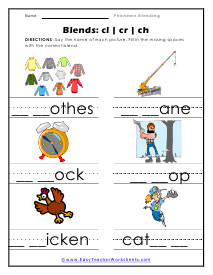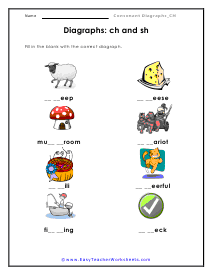This is one of the most comprehensive collections of phonics worksheets available online. We encourage you to work with this section on a daily basis through the school year. The worksheet categories that you find below will lead you to areas that are great for pre-readers. Please Note: You will find all of these phonics topic categories available off of the navigation bar on the left. I would highly recommend getting your color ink out for these guys.
Phonics Worksheet Categories
Click the buttons to be transported to all the worksheets for that topic.

Add and Subtract Phonemes
This focuses on the concept of phonemic awareness which is your ability hear and find the smallest unit of sound.

Blends
We look at common clusters of letters and consonants and get some practice on creating words by sounding them out.

Consonant Digraphs -ch
We look at how this digraph comes together to make words such as: beach, chess, chocolate, and chalk.

Consonant Digraphs -sh
This is one of the more common diagraphs that you will come across in the English language. You will find its use in words such as: shark, ship, dash, and push.

Consonant Digraphs -th
A diagraph is two letters that make a single sound. This diagraph is found in such words as: theme, throw, thick, and thief.

Consonant Digraphs -wh
These terms tend to make up the thickest part of the dictionary. These often tend to move around with sounds more.

CVC Words
These words follow a consonant, vowel, consonant letter pattern. When ever a consonant follows a vowel, it forms a closed syllable and forces the vowel to say its sound.

CVVC Words
These terms follow a consonant, vowel, vowel, consonant letter pattern. A good number of sight words fall into this category. You will trace and then write the entire word on your own.

CVCe (Silent E) Words
These terms follow the CVC pattern, but end in a silent e. This section will help students learn to pronunciation terms that are not straight forward because of the silent e.

Letters and Sounds
This is a really nice mix of sounds that are produced by a number of different letters. You may find the use for other terms, but pay attention to picture that is provided for you.

Long/Short Aa Vowel Sounds
Depending on a letters position in a word it can be stressed differently and make some unique sounds.



Long/Short Oo Vowel Sounds
These worksheets take a look at the sounds made by the fourth vowel of the alphabet. Common long O words include: home, bone, and vote.

Long/Short Uu Vowel Sounds
The last vowel of the alphabet is often the trickiest for students. Therefore, we commonly teach them in the order that they appear in the alphabet.

Long Vowels
We just broke down each vowel, so why not mix them all together and see what we know. This is a nice review of all those sounds in one.

Phoneme Isolation
Students start to break apart words and identify segments of phonemes found within them. You can do these worksheets orally too.

Phoneme Segmenting
This is when you take a word and break it down into the individual sounds you hear in the word.

Phoneme Substitution
This is where we create new words from old ones by just swapping out a phoneme.

Short Vowels
These are the vowels that just do not sound like their letter within the words they sit in.

What is Phonics?
Phonics is the process of teaching to read and correlate the sounds of alphabet letters. Kids can learn the sounds of different letters using phonological awareness. Phonics helps students learn to identify relationships between words and sounds. This helps them learn to master the alphabet pretty quickly. The techniques that we explore here will help you how to logical organize the sounds of words, it will also help you learn to predict the pronunciation of terms that are new to you. Research has shown that phonics instruction can dramatically improves a student's ability to recognizing new vocabulary and understand what they read. Phonics is a method for approaching teaching student how to both read and write. One of the main focuses when reading is to sound out words. Over my teaching career I have taught using both phonics and whole language as my core strategies. I have found students that begin their pre-reading skills with phonics end up being better spellers later in life. My guess is that it is because they started reading words by always sounding it out.
What is Decoding?
Decoding is the process of translating words from a printed format to speech. Phonics plays a crucial role in helping kids to decode new vocabulary.
How to Teach Phonics and Decoding
Phonics and decoding are the pre-requisites of reading and comprehension. Teaching phonics to elementary school kids is an essential step. It sets the ground for literary learning students. To make sure your kids pronounce the words correctly, it is mandatory to teach them phonics first. Fluent reading and comprehension come from phonological knowledge. If your kids can decode the sound of alphabet letters correctly, they can distinguish between different different terms.
If you want your kids to learn to decode the sounds of letters correctly, we have a few practical ways to help you accomplish your goal.
You can teach phonics and decoding in many ways. We have listed some of the most effective methods below to help you teach your child.
Start With Individual Letters
Teaching phonics to elementary school kids requires a systematic approach. You may need to start with the easy letters first. As we already know, English alphabet letters vary based on their sounds. You may not want to overburden your kids on the first day. Once they learn the easy ones, you can proceed to the complicated letters. If you teach them the two together, they may get confused.
For example, the sounds of the letters 'A', 'B,' and 'D' are relatively easier to learn. However, the sounds of the letters 'C', 'Y,' and 'X' may require time for phonological awareness.
Make Small Word Combinations
The English language has a variety of vocabulary. You can start with simpler (to pronounce) words. Try focusing on three-letter or four-letter words. Such terms are easy to understand and decode. For example, words like “Mat,” Top,” and “Ball” are relatively easier to pronounce. Teaching your kids to learn small words with correct sounds can boost their confidence to learn more. You can gradually add more complex vocabulary to the list.
You may teach them how to link the sounds of two letters and pronounce them collectively. Once they understand, ask them to self-reflect to test their decoding ability.
Incorporate Alphabet Letters into Games
Kids love to play. You can test their decoding abilities by incorporating alphabet letters into games. Using wordplay songs can help the kids learn the sounds of different letters much faster. Melodies are relatively easier to remember for elementary kids. You may also use letter cards to enhance their phonological skills.
Playing word-building games can also help students to decode better. They can arrange alphabets in the correct order to create a word.
Organize Decoding-To-Text Activities
Once the kids learn to pronounce different letters, you can arrange writing activities to help them practice. Writing the learned vocabulary in a notebook can improve their comprehension. Without learning to write the words, they may forget about the correct pronunciation and spelling.
You can also conduct word-scoring games in the classroom. Elementary school kids can create unique words from the same letter to achieve points. Such games help students to challenge themselves and perform better.
Wrapping Up
Your child's ability to learn a language depends on their phonological and decoding expertise. If any of the ways mentioned above do not help, you can also try other techniques. Feel free to search for effective methods to teach phonics and decoding online to improve your child's reading skills.

